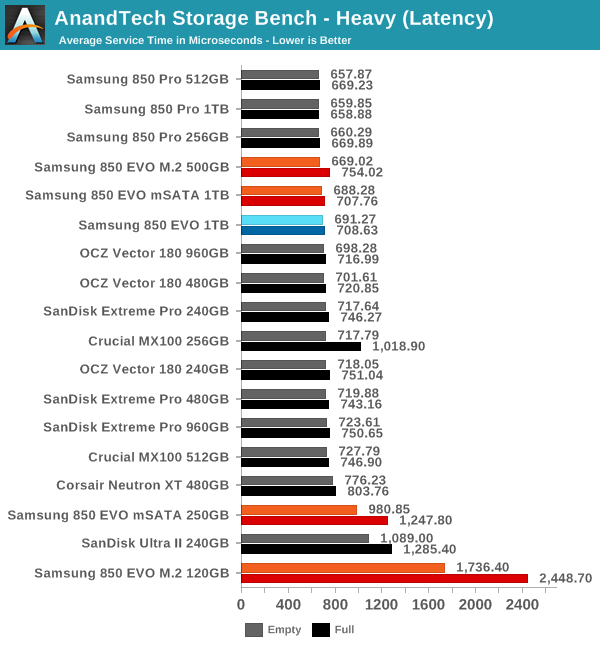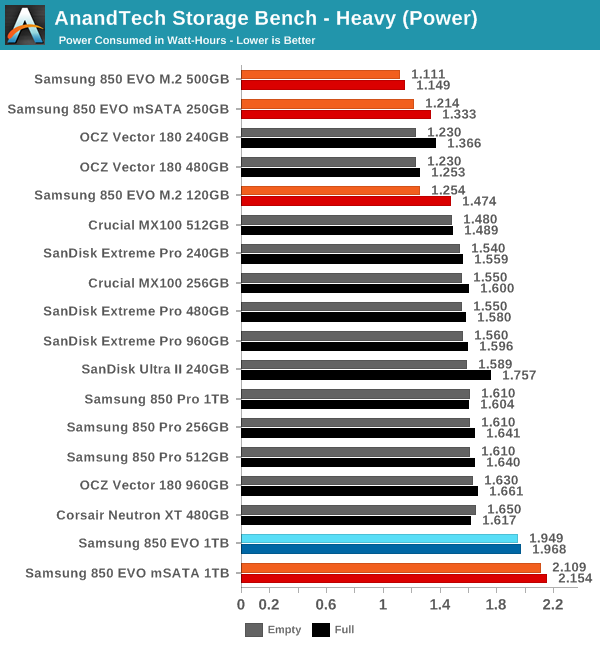The Samsung SSD 850 EVO mSATA/M.2 Review
by Kristian Vättö on March 31, 2015 10:00 AM ESTAnandTech Storage Bench - Heavy
While The Destroyer focuses on sustained and worst-case performance by hammering the drive with nearly 1TB worth of writes, the Heavy trace provides a more typical enthusiast and power user workload. By writing less to the drive, the Heavy trace doesn't drive the SSD into steady-state and thus the trace gives us a good idea of peak performance combined with some basic garbage collection routines.
| AnandTech Storage Bench - Heavy | ||||||||||||
| Workload | Description | Applications Used | ||||||||||
| Photo Editing | Import images, edit, export | Adobe Photoshop | ||||||||||
| Gaming | Pllay games, load levels | Starcraft II, World of Warcraft | ||||||||||
| Content Creation | HTML editing | Dreamweaver | ||||||||||
| General Productivity | Browse the web, manage local email, document creation, application install, virus/malware scan | Chrome, IE10, Outlook, Windows 8, AxCrypt, uTorrent, AdAware | ||||||||||
| Application Development | Compile Chromium | Visual Studio 2008 | ||||||||||
The Heavy trace drops virtualization from the equation and goes a bit lighter on photo editing and gaming, making it more relevant to the majority of end-users.
| AnandTech Storage Bench - Heavy - Specs | ||||||||||||
| Reads | 2.17 million | |||||||||||
| Writes | 1.78 million | |||||||||||
| Total IO Operations | 3.99 million | |||||||||||
| Total GB Read | 48.63 GB | |||||||||||
| Total GB Written | 106.32 GB | |||||||||||
| Average Queue Depth | ~4.6 | |||||||||||
| Focus | Peak IO, basic GC routines | |||||||||||
The Heavy trace is actually more write-centric than The Destroyer is. A part of that is explained by the lack of virtualization because operating systems tend to be read-intensive, be that a local or virtual system. The total number of IOs is less than 10% of The Destroyer's IOs, so the Heavy trace is much easier for the drive and doesn't even overwrite the drive once.
| AnandTech Storage Bench - Heavy - IO Breakdown | |||||||||||
| IO Size | <4KB | 4KB | 8KB | 16KB | 32KB | 64KB | 128KB | ||||
| % of Total | 7.8% | 29.2% | 3.5% | 10.3% | 10.8% | 4.1% | 21.7% | ||||
The Heavy trace has more focus on 16KB and 32KB IO sizes, but more than half of the IOs are still either 4KB or 128KB. About 43% of the IOs are sequential with the rest being slightly more full random than pseudo-random.
| AnandTech Storage Bench - Heavy - QD Breakdown | ||||||||||||
| Queue Depth | 1 | 2 | 3 | 4-5 | 6-10 | 11-20 | 21-32 | >32 | ||||
| % of Total | 63.5% | 10.4% | 5.1% | 5.0% | 6.4% | 6.0% | 3.2% | 0.3% | ||||
In terms of queue depths the Heavy trace is even more focused on very low queue depths with three fourths happening at queue depth of one or two.
I'm reporting the same performance metrics as in The Destroyer benchmark, but I'm running the drive in both empty and full states. Some manufacturers tend to focus intensively on peak performance on an empty drive, but in reality the drive will always contain some data. Testing the drive in full state gives us valuable information whether the drive loses performance once it's filled with data.

In the Heavy trace the 850 EVO scores highly. As I've said before, it seems that only Samsung has found the secret recipe to boost performance under SATA 6Gbps because no other manufacturer comes close to it in this benchmark.

Moving on to latency and the 850 EVO still keeps its lead compared to other manufacturers' drives. The difference is nowhere near as significant as in the throughput metric above, but the 850 EVO is still without a doubt one of the highest performing drives on the market. The smaller capacities are a bit of a disappointement, though, because the 250GB mSATA loses to MX100 by a quite hefty margin, but it still beats the Ultra II for what it's worth.

The smaller capacities, especially the 120GB one, seem to have quite a few high latency IOs. I wouldn't say the situation for the 250GB model is critical, but I do think that individuals with heavier workloads should focus on the 500GB and higher capacities in order to avoid any storage performance issues.

But in terms of power the 850 EVO is very efficient at smaller capacities. Given that mSATA and M.2 standards are mostly used in mobile applications, this is very good news.










58 Comments
View All Comments
Flunk - Tuesday, March 31, 2015 - link
This is what makes M.2 such an annoying standard. They tried to accommodate everything and ended up with compromises that don't make sense and will probably be written out of the standard in a future version.setzer - Tuesday, March 31, 2015 - link
Also don't forget about the single and double sided thing as noted in the article there are some laptops that only accept single-sided.Also there is nothing to prevent a manafucturer to put a B+M keyed M.2 socket but only connect the USB traces. See toshiba's Z30's laptops for a pratical example.
The joys of M.2 are great :P
ilkhan - Wednesday, April 1, 2015 - link
Answer: Ports should be wired and keyed for sata and pci-e.devices can be whatever they need.
The keys are there to prevent a pci-e device in a sata host.
rtho782 - Tuesday, March 31, 2015 - link
I still don't see a reason to replace my ageing 256GB Samsung 830s in RAID 0.I really want a decent PCIe NVMe M.2 or SATAe SSD of about 500GB, preferably Samsung and 3D nand. But nothing :(
MrCommunistGen - Tuesday, March 31, 2015 - link
Looks like the 500GB model is the performance sweet spot.I'm not that surprised with the different performance profile on the 1TB model since it is using the older MEX controller. Could the 1TB's stuttering under steady state load be due to thermal throttling of the controller?
I was not expecting the smaller capacity drives, particularly the 120GB model to have such (relatively) low performance. Still, compared to drives of yesteryear, performance is still quite good. My HTPC has an old 96GB Kingston V+100 but still feels pretty snappy. I'm sure that even the 120GB 850 Evo would run circles around that drive - and as such have plenty of performance for an average user.
sonicmerlin - Friday, April 3, 2015 - link
Ha I have that exact same Kingston drive in my desktop. I can only install like 1 or 2 games at once, but it's totally worth it. I doubt any SSD upgrades would make my computer feel even faster than it already is.Mrduder11 - Tuesday, March 31, 2015 - link
I can't remeber where I read it but should we be concerned about these drives getting too hot where it affects performance?Mecharon1 - Tuesday, March 31, 2015 - link
Is this drive bootable? More specifically, can I install my OS on the 120GB M.2 version and use something else for bulk storage?foxtrot1_1 - Tuesday, March 31, 2015 - link
That depends on the motherboard, but Windows 8.1 and Windows 10 should allow you to boot from M.2 no problem. Your BIOS is the issue.This is a golden age for PC hardware (at least, it will be this fall) but the proliferation of specifications and standards is really stupid. Get your act together, OEMs.
Kristian Vättö - Wednesday, April 1, 2015 - link
SATA is always bootable regardless of the form factor and OS, and the 850 EVO is a SATA drive (M.2 supports both SATA and PCIe). The bootability issue only applies to PCIe M.2 drives.